Agroecology Reading time 2 min
The control of grain development
Published on 13 July 2017

The production of grains and seeds is a fundamental challenge for our diet, and for industry, agriculture and the environment. Improving this production may contribute to a sustainable intensification of agriculture so that it can feed the growing global population. Furthermore, storage carbohydrates in grains constitute an alternative to fossil carbon for green chemistry. As a result, there is an increasing demand to produce grain that is better suited to different uses as raw materials or seeds. Finally, this challenge is clearly being amplified by the climate changes of recent decades that are already affecting production.
In order to better understand and model the structure and role of the regulatory network that controls grain development in Arabidopsis thaliana, INRA scientists and their colleagues have studied the (epi)genetic and molecular mechanisms that govern grain development and quality.
The development and maturation of grains are thus tightly regulated at a transcriptional level by the so-called “LAFL” regulatory network, which involves type B3 factors such as ABI3, FUS3 and LEC2 (AFL-B3). The expression of AFL genes is itself strictly controlled during grain development and repressed during vegetative growth, thanks notably to chromatin regulation. The scientists have identified and characterised in detail the numerous direct targets of LAFL regulators, such as genes coding for an oleosin (oleosins are proteins associated with the lipid bodies in which the grains of oilseed plants store their lipid reserves) and MYB factors involved in regulating the biosynthesis of storage lipids.
This work has opened the way to:
- A clearer understanding of the actors in the LAFL network and their functions in A. thaliana,
- Study of the impact of abiotic stresses (e.g. temperature and drought) and of biotic factors on regulation of the so-called “LAFL” network and grain filling,
- The identification of orthologous genes and the characterisation of mechanisms involved in different arable plants (wheat, maize, rapeseed, rice or camelina).
Find out more
Troncoso-Ponce MA. et al. 2016. Transcriptional Activation of Two Delta-9 Palmitoyl-ACP Desaturase Genes by MYB115 and MYB118 Is Critical for Biosynthesis of Omega-7 Monounsaturated Fatty Acids in the Endosperm of Arabidopsis Seeds. Plant Cell. 10: 2666.
Fiume E et al. 2016. TWS1, a Novel Small Protein, Regulates Various Aspects of Seed and Plant Development. Plant Physiol. 172: 1732.
Fatihi A et al. 2016. Deciphering and modifying LAFL transcriptional regulatory network in seed for improving yield and quality of storage compounds. Plant Sci. 250: 198.
Xu W et al. 2016. Endosperm and Nucellus Develop Antagonistically in Arabidopsis Seeds. Plant Cell. 28: 1343.
Baud S. et al. 2016. Deciphering the Molecular Mechanisms Underpinning the Transcriptional Control of Gene Expression by Master Transcriptional Regulators in Arabidopsis Seed. Plant Physiol. 171: 1099.
Troncoso-Ponce MA et al. 2016. New insights on the organization and regulation of the fatty acid biosynthetic network in the model higher plant Arabidopsis thaliana. Biochimie 120: 3.
